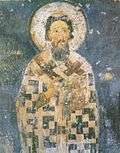Saint Sava Serbian Orthodox Monastery and Seminary
The Saint Sava Serbian Orthodox Monastery and School of Theology in Libertyville, Illinois is a monastery and professional theological school in the Serbian Orthodox Church in the USA and Canada. The school is a collocated facility with the monastery.
.jpg)
The school possesses a library of 8,000 titles.
History
The monastery was founded in 1923 by Montenegrin Serb Bishop Saint Mardarije as a school for the Serbian Orthodox Church.[1] It is unique in North America among Orthodox seminaries for being linked to and deriving its traditional Orthodox ethos from a monastery out of which it grew.
Dionisije Milivojević was appointed the bishop of the American-Canadian Diocese in 1939. During World War II, the Libertyville monastery became an American refuge for Orthodox Serbs. In 1964, Serbian Patriarch German defrocked American Bishop Dionisije Milivojević over political and administrative issues. This forced a split between the Serbian and North American branches of the church. The result was two separate North American churches—the Serbian Orthodox Church in the USA and Canada in Libertyville and the Diocese of New Gracanica – Midwestern America in nearby Third Lake. The Illinois Supreme Court deemed that this schism was a violation of the mother church's regulations and forbade recognition of Bishop Dionisije. However, in 1976, the United States Supreme Court ruled that this was in violation of the First and Fourteenth Amendment to the United States Constitution in Serbian Orthodox Diocese v. Milivojevich.[2]
Peter II of Yugoslavia, the last Yugoslav king, lived at the monastery after being exiled by Josip Broz Tito. He died at the church in 1970 and his will stipulated that he wished to be buried there. More than 10,000 attended his funeral. He lay there until his remains were repatriated to Serbia in 2013.[3][4]
The property is listed on the National Register of Historic Places.
See also
- Serbs in USA
- Serbs in Canada
- Serbs in South America
- St. Pachomious Monastery
- New Gračanica Monastery
- Monastery of St. Paisius, Safford
- St. Xenia Serbian Orthodox Skete
- St. Archangel Michael Skete
- Saint Petka Serbian Orthodox Church
| Wikimedia Commons has media related to Church of the St. Sava Serbian Orthodox Monastery (Libertyville, Illinois). |
References
- Hucke, Matt; Bielski, Ursula (1999). Graveyards of Chicago. Chicago, IL: Lake Claremont Press. p. 202. ISBN 0964242648.
- Cox, John K. (2002). The History of Serbia. Westport, CT: Greenwood Press. p. 117. ISBN 0313312907.
- Tarm, Michael (4 March 2007). "King's body in U.S. may head to homeland". The Boston Globe. boston.com. Associated Press. Retrieved 23 January 2013.
- "HM King Peter II Returns Home after 72 Years". Balkans.com Business News. Balkans.com. 20 January 2013. Archived from the original on 14 January 2014. Retrieved 23 January 2013.
Sources
- Vuković, Sava (1998). History of the Serbian Orthodox Church in America and Canada 1891–1941. Kragujevac: Kalenić.CS1 maint: ref=harv (link)
- This article incorporates text from St. Sava's Serbian Orthodox Seminary (Libertyville, Illinois) at OrthodoxWiki which is licensed under the CC-BY-SA and GFDL.
